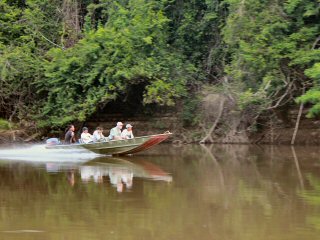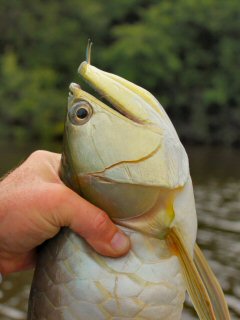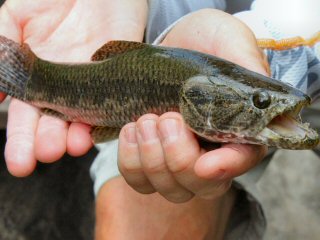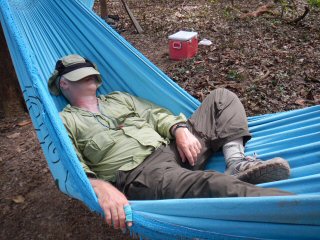 Last nights unsuccessful fishing on Awarmi Slough was our warm-up session. Indeed there were arapaima, but really Awarmi is close to the Rewa Eco-Lodge and the best option for the half day of fishing available. It’s a good place to get tuned up, let guides to see how you cast and get acquainted. Every lodge does the same on the first day. From today on we’ll head deeper to more prime fishing locations.
Last nights unsuccessful fishing on Awarmi Slough was our warm-up session. Indeed there were arapaima, but really Awarmi is close to the Rewa Eco-Lodge and the best option for the half day of fishing available. It’s a good place to get tuned up, let guides to see how you cast and get acquainted. Every lodge does the same on the first day. From today on we’ll head deeper to more prime fishing locations.
 At 5 AM Tim Brune and the dudes from CA, Jim and Alex, had breakfast and coffee. Here in Guyana it’s already light by 5. We learned Alex already picked up an intestinal bug and wasn’t fishing. A real bummer but he’s an older guy and you can hardly blame him. Jim had his boat all to himself.
At 5 AM Tim Brune and the dudes from CA, Jim and Alex, had breakfast and coffee. Here in Guyana it’s already light by 5. We learned Alex already picked up an intestinal bug and wasn’t fishing. A real bummer but he’s an older guy and you can hardly blame him. Jim had his boat all to himself.
After breakfast we took an hour boat ride upstream. Once there we gathered our gear and hiked through some dense forest for about ten minutes. We came to a beautiful lagoon called Kumaka. Awaiting us were dugout canoes to fish from. We loaded as quietly as possible then guides Terry and Cane eased us along.
 Kumaka starts out as a narrow arm in a beautiful jungle setting of a canopy of overhanging trees. Then it opens up to a small lake. There wasn’t an ounce of wind and the reflection of the forest on the water was so clear it was hypnotizing. The banks are strung with fallen trees and amongst them havoc goes on as peacock bass, arowana, wolf fish and more crush, kill and destroy to make a living. Other than amazing bird sounds, the splashes were the only thing heard.
Kumaka starts out as a narrow arm in a beautiful jungle setting of a canopy of overhanging trees. Then it opens up to a small lake. There wasn’t an ounce of wind and the reflection of the forest on the water was so clear it was hypnotizing. The banks are strung with fallen trees and amongst them havoc goes on as peacock bass, arowana, wolf fish and more crush, kill and destroy to make a living. Other than amazing bird sounds, the splashes were the only thing heard.
 Five minutes behind us there’s another boat that will be with us all week. In this boat there’s scientist Dr. Lesley de Souza and her assistant Jaclyn Mellini. Lesley does research for the Shedd Aquarium and is an expert on South American freshwater fish and extremely knowledgeable on the arapaima. She has been long studying the arapaima of Guyana and has several fish in the area tagged. This week we hope to catch one of her previously tagged fish to see if he’s grown and help her tag few more. Lesley is presently dedicating her life to learn more about this rare and amazing creature so she can do her part to help protect them.
Five minutes behind us there’s another boat that will be with us all week. In this boat there’s scientist Dr. Lesley de Souza and her assistant Jaclyn Mellini. Lesley does research for the Shedd Aquarium and is an expert on South American freshwater fish and extremely knowledgeable on the arapaima. She has been long studying the arapaima of Guyana and has several fish in the area tagged. This week we hope to catch one of her previously tagged fish to see if he’s grown and help her tag few more. Lesley is presently dedicating her life to learn more about this rare and amazing creature so she can do her part to help protect them.
Tim took the bow first today. I didn’t mention it yesterday, but Tim caught two arapaima on his trip here in March. Being I don’t have a feel for this fish yet, I thought it best to observe. I kicked back and watched the technique.
 After creeping along for fifteen or so minutes we saw the first arapaima roll. The oversized freshwater fish was out of casting range but at least they were here. A good sign. It was about another fifteen minutes before the next roll but it too was out of range. The next hour continued this way. I was excited simply to see fish, but I could tell Terry, Cane and Tim were restless. The arapaima were unusually inactive for their liking.
After creeping along for fifteen or so minutes we saw the first arapaima roll. The oversized freshwater fish was out of casting range but at least they were here. A good sign. It was about another fifteen minutes before the next roll but it too was out of range. The next hour continued this way. I was excited simply to see fish, but I could tell Terry, Cane and Tim were restless. The arapaima were unusually inactive for their liking.
 The last thing the arapaima need is any help but we were about to get noisy and warn them of our presence. The aggressive murder of baitfish from peacocks around the sunken trees along the bank was getting tough to take. Eventually Tim launched in the area of fleeing baitfish and in two strips hooked one up. In came the first fish of the trip, the most pale colored peacock (hopefully to be identified by Lesley) I’ve ever seen with a strange spot under the rear of his dorsal to go along with the standard on the tail.
The last thing the arapaima need is any help but we were about to get noisy and warn them of our presence. The aggressive murder of baitfish from peacocks around the sunken trees along the bank was getting tough to take. Eventually Tim launched in the area of fleeing baitfish and in two strips hooked one up. In came the first fish of the trip, the most pale colored peacock (hopefully to be identified by Lesley) I’ve ever seen with a strange spot under the rear of his dorsal to go along with the standard on the tail.
 I couldn’t hold back, within seconds Tim and I were both pounding the banks with our lighter 9-weight rods and the peacocks were in trouble. During the next twenty minutes Tim and I ripped in ten of the voracious cichlids sending explosions of flying water everywhere. True fishing fools in action!
I couldn’t hold back, within seconds Tim and I were both pounding the banks with our lighter 9-weight rods and the peacocks were in trouble. During the next twenty minutes Tim and I ripped in ten of the voracious cichlids sending explosions of flying water everywhere. True fishing fools in action!
 We made a lot of racket catching the peacocks. I’m sure we banged the boat and hooted and hollered. Not good when seeking the illusive arapaima. It was probably a waste of time to go back to the arapaima pursuit. But not knowing how detrimental noise is, I took the bow and stood silently for an hour without a cast. A colony of 4- 8-foot long fish were nowhere to be found. We blew it on them, but there’s always bycatch.
We made a lot of racket catching the peacocks. I’m sure we banged the boat and hooted and hollered. Not good when seeking the illusive arapaima. It was probably a waste of time to go back to the arapaima pursuit. But not knowing how detrimental noise is, I took the bow and stood silently for an hour without a cast. A colony of 4- 8-foot long fish were nowhere to be found. We blew it on them, but there’s always bycatch.
With the arapaima uncatchable and noticing that Tim and I needed to get some casting and fishing out of our systems, Cane pointed out some distant arowana. Arowana are prehistoric looking fish that feed on about anything they can catch. They are particularly known to leap up into the trees to snatch insects, spiders, bats and even small birds. I’ve hammered on them a few times in Brazil and have a passion for fly fishing for arowana. It was time to go get them.
 While Tim stuck to his 9-weight and popper, I whipped out my 9-foot 6-weight Winston already rigged from home with a gargantuan Chernobyl ant on a saltwater 1/0 hook (designed by my friends in Bolivia for pacu). By the time I got my concoction in the water, Tim was already landing a beauty. I flicked a couple pics then launched my fly.
While Tim stuck to his 9-weight and popper, I whipped out my 9-foot 6-weight Winston already rigged from home with a gargantuan Chernobyl ant on a saltwater 1/0 hook (designed by my friends in Bolivia for pacu). By the time I got my concoction in the water, Tim was already landing a beauty. I flicked a couple pics then launched my fly.
 My Chernobyl landed in front of two cruisers. We watched as one of the arowana sped for my fly. Just as he got to the oversized ant that appeared he was going to blow to smithereens, he put on the brakes then sipped the Chernobyl like a cutthroat on Flat Creek. It’s a sight no fly fisher can forget and the exact reason I fish arowana with trout flies.
My Chernobyl landed in front of two cruisers. We watched as one of the arowana sped for my fly. Just as he got to the oversized ant that appeared he was going to blow to smithereens, he put on the brakes then sipped the Chernobyl like a cutthroat on Flat Creek. It’s a sight no fly fisher can forget and the exact reason I fish arowana with trout flies.
 Tim and I finished up the morning with a dozen arowana. We also caught more peacocks and I caught a huri. I may be confused but the huri appears to be a type of wolf fish. Another one to check up on with the Dr. A neat Amazon fish nonetheless.
Tim and I finished up the morning with a dozen arowana. We also caught more peacocks and I caught a huri. I may be confused but the huri appears to be a type of wolf fish. Another one to check up on with the Dr. A neat Amazon fish nonetheless.
 The most interesting fish of the morning didn’t eat a fly at all but was rather grabbed by the tail. It’s known in Guyana (English speaking by the way) as the tiger cat; better known in the rest of the Amazon as the striped Surubi catfish. Evidently this particular one has some issues because we saw him swimming like he was wounded. He was an easy target for Terry and he scooped him up. Unfortunately the camera did something strange and the pic overexposed. But you get the idea of what a unique fish this is.
The most interesting fish of the morning didn’t eat a fly at all but was rather grabbed by the tail. It’s known in Guyana (English speaking by the way) as the tiger cat; better known in the rest of the Amazon as the striped Surubi catfish. Evidently this particular one has some issues because we saw him swimming like he was wounded. He was an easy target for Terry and he scooped him up. Unfortunately the camera did something strange and the pic overexposed. But you get the idea of what a unique fish this is.
 During lunch the hammocks came out and we relaxed for a few hours. During the noon hours the sun is excruciatingly hot and although psychos like Tim and I could keep fishing, most people need some shade and a break. I caught up in the journal and divulged on a couple Banks Beers.
During lunch the hammocks came out and we relaxed for a few hours. During the noon hours the sun is excruciatingly hot and although psychos like Tim and I could keep fishing, most people need some shade and a break. I caught up in the journal and divulged on a couple Banks Beers.
3 PM is when fishing resumes. We went further up river then hiked into Banana Sucker Pond. I’m not sure where the name comes from but it’s a funny one. Here two aluminum boats awaited us that were dragged in by the Rewa staff. We headed out and were immediately on to rolling arapaima. These ones were in casting range.
 But no luck. Tim and I took turns landing our flies right in the zone of numerous arapaima. At one time Tim got a tap. I can’t imagine a massive arapaima just tapping a fly but he and Terry are sure it was. I have much to learn about fly fishing for this new fish.
But no luck. Tim and I took turns landing our flies right in the zone of numerous arapaima. At one time Tim got a tap. I can’t imagine a massive arapaima just tapping a fly but he and Terry are sure it was. I have much to learn about fly fishing for this new fish.
A day and a half and no arapaima. Hopefully tomorrow will be the day.














Awesome, the tiger catfish and arowana are such cool looking fish. managed one tiger catfish when I was there. You guys will get your arapaima! Enjoy.
The Arowana loks awesome, almost gold. That’s a cool fish.. did they make the popping noise?